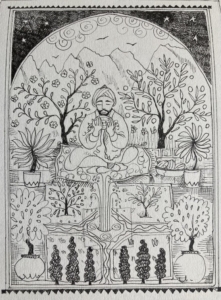This article is in the Windows into Illustration Category
Windows into Illustration: Jane Ray
 Jane Ray’s illustrations are distinctive, sumptuous and jewel bright. In a special Windows into Illustration feature, she describes how her training in ceramics influenced her approach to illustrating The Story of Babur: Prince, Emperor, Sage.
Jane Ray’s illustrations are distinctive, sumptuous and jewel bright. In a special Windows into Illustration feature, she describes how her training in ceramics influenced her approach to illustrating The Story of Babur: Prince, Emperor, Sage.
I have been illustrating books for 30 years now, but my original training was in 3D design – ceramics, glass and metal – and during my time at art school I spent many hours in the V&A delighting in the art and the craftsmanship I found there. Pottery, tiles, enamels, textiles and above all, the exquisite Mughal miniature paintings all influenced my work and my thinking – the colour, pattern and beauty was astounding.
After graduating, I moved towards illustration and these same influences fed into the books I was commissioned to work on – collections of fairy tales, myths and legends from all over the world, bible stories, and the ancient tale of Lugalbanda, from Sumer or Ancient Iraq (Kathy Henderson/Walker Books). I illustrated collections of myths and legends of the Near East, and The Arabian Nights for The Folio Society.
So it was a pleasure, and an honour, to be asked to illustrate The Story of Babur: Prince, Emperor, Sage retold for children by the Nepalese children’s author, Anuradha.
This, of course, is a true story, not myth or fable, based on Babur’s own writings of his rule in the 1520s, and a detailed account of his life and epic achievements.
Babur was a fascinating character – on the one hand, an invader, a conqueror, capable of brutality and destruction. On the other hand, here was a scholar who loved nature, art, science and music. Babur was a son, a husband, a father, and a friend, often revealing great vulnerability and humanity in his writings.
Anuradha’s writing leapt across continents, from Nepal to the UK, vividly retelling Babur’s story. We worked together on this book against the backdrop of both the Pandemic, and the tragedy in Afghanistan.
I sat in the studio painting scenes from 16th-century Kabul, while listening to news reports of 21st-century Kabul….
I started the project, as I start every project, with a sketchbook, drawing faces, clothes, trees, and buildings, and generally getting a feel for the stories. I loved getting to know Babur, from childhood, to young warrior, to husband and father.
Because we were working on this book during Lockdown, I wasn’t able to access the glorious Mughal miniature paintings at the V&A as frequently as I usually would, and the one or two visits I made were frustrating as I juggled mask and steamed up glasses!
But I managed to find plenty of imagery via the internet, and I also found a copy of The Illustrated Baburnama by Som Prakash Verma (Routledge), a full translation of Babur’s writings, accompanied by the most exquisite contemporary manuscript paintings, which was invaluable.
From my research I was able to get a sense of the people in the story, their clothes, buildings, and the landscape they inhabited. It was never my intention to be a slave to historic detail – that is not my style. But I wanted to have a sense of colour, pattern and structure that would ring true. Common to just about every culture of the time, women didn’t feature much in the stories, and so I deliberately sought to make them visible where possible. Scala, the publisher of the book, commissioned me to provide one illustration for each of the 12 chapters of the book, and I decided to create an opening painting, not necessarily illustrating an actual incident in the story (though some do), but rather creating an impression of the story, something of the atmosphere of what was happening.
I used my usual materials – watercolour, ink and a liquid gold that subtly lights up the images, on a heavy watercolour paper, and I treated each image as a little icon of colour and richness. This was one of those projects that, as an illustrator, you don’t want to end. But now that the writing and the illustrations are complete, Babur is setting out on his epic journeying once again.
The Story of Babur: Prince, Emperor, Sage is published by Scala Arts & Heritage Publishers, 978-1785513947, £12.95 hbk.











